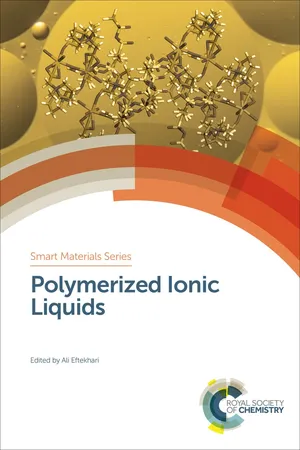
- 541 pages
- English
- ePUB (mobile friendly)
- Available on iOS & Android
Polymerized Ionic Liquids
About this book
The applications of ionic liquids can be enormously expanded by arranging the organic ions in the form ofa polymer architecture. Polymerized ionic liquids (PILs), also known as poly(ionic liquid)s or polymeric ionic liquids, provide almost all features of ionic polymers plus a rare versatility in design. The mechanical properties of the solid or solid-like polymers can also be controlled by external stimuli, the basis for designing smart materials.
Known for over four decades, PILs are a member of the ionic polymers family. Although the previous forms of ionic polymers have a partial ionicity, PILs are entirely composed of ions. Therefore, they offer a better flexibility for designing a responsive architecture as smart materials. Despite the terminology, PILs can be synthesized from solid organic ionic salts since the monomer liquidity is not a requirement for the polymerization process. Ionicity can also be induced to a neutral polymer by post-polymerization treatments.
This is indeed an emerging field whose capabilities have been somehow overshadowed by the popularity of ionic liquids. However, recent reports in the literature have shown impressive potentials for the future. Written by leading authors, the present book provides a comprehensive overview of this exciting area, discussing various aspects of PILs and their applications as smart materials. Owing to the novelty of this area of research, the book will appeal to a broad readership including students and researchers from materials science, polymer science, chemistry, and physics.
Frequently asked questions
- Essential is ideal for learners and professionals who enjoy exploring a wide range of subjects. Access the Essential Library with 800,000+ trusted titles and best-sellers across business, personal growth, and the humanities. Includes unlimited reading time and Standard Read Aloud voice.
- Complete: Perfect for advanced learners and researchers needing full, unrestricted access. Unlock 1.4M+ books across hundreds of subjects, including academic and specialized titles. The Complete Plan also includes advanced features like Premium Read Aloud and Research Assistant.
Please note we cannot support devices running on iOS 13 and Android 7 or earlier. Learn more about using the app.
Information
1.1 Introduction

1.2 ILs in Conventional Free Radical Polymerization
Table of contents
- Cover
- Title
- Copyright
- Foreword
- Preface
- Contents
- Chapter 1 Polymerization in Ionic Liquids
- Chapter 2 Porous Ionic Liquid Materials
- Chapter 3 Cationic and Anionic Polymerized Ionic Liquids: Properties for Applications
- Chapter 4 Switchable Hydrophobicity and Hydrophilicity
- Chapter 5 Switchable Polarity Liquids
- Chapter 6 Stimuli Responsive Smart Fluids Based on Ionic Liquids and Poly(ionic liquid)s
- Chapter 7 Thermo-responsive Poly(ionic liquid) Nanogels Prepared via One-step Cross-linking Copolymerization
- Chapter 8 Redox-active Immobilized Ionic Liquids and Polymer Ionic Liquids
- Chapter 9 Doping Polymers with Ionic Liquids to Manipulate Their Morphology and Membrane Gas Separation Properties
- Chapter 10 Ionic Liquid-modified Poly(Vinylidene Fluoride): from High Performance Anti-static Materials to Flexible Dielectric Materials
- Chapter 11 Ionic Liquids as Tools in the Production of Smart Polymeric Hydrogels
- Chapter 12 Preparation of Functional Polysaccharides and Related Materials Combined with Ionic Liquids
- Chapter 13 Tailoring Transport Properties Aiming for Versatile Ionic Liquids and Poly(Ionic Liquids) for Electrochromic and Gas Capture Applications
- Chapter 14 Wearable Energy Storage Based on Ionic Liquid Gels
- Chapter 15 Ionic Liquids in Wearable Chemical Sensors1
- Chapter 16 Ionic Electrochemical Actuators
- Chapter 17 Capturing CO2 with Poly(Ionic Liquid)s
- Chapter 18 Ionic Liquid-based Polymers and Crystals for Dye-sensitized Solar Cells
- Subject Index